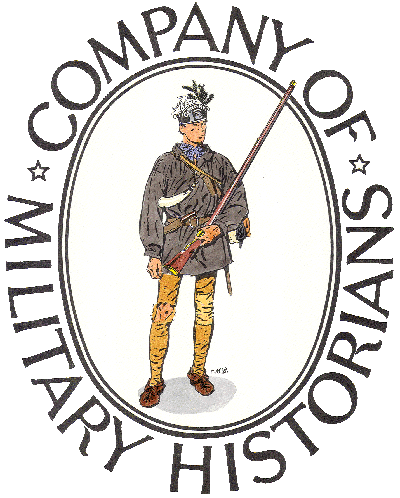
Mess Rules
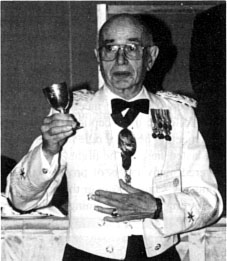
COL George Pappas, USA (ret.) presenting the Founders' Cup.
- CMH Mess Rules
- History of CMH Mess
- Prayer & Benediction
- Mess Devices
Approved by the Board of Governors October 2003
Formal Mess Occasions
The Company of Military Historians may schedule a formal dinner whenever the cost, the facilities available, and the number of guests expected make such an occasion feasible and desirable. In planning a formal mess occasion, local committees may draw upon the following:
1. Food and Service
a. It should be a function of the local committee to confer with the headwaiter and chefs well in advance of the proposed formal dinner to ensure that every effort is made to achieve the best possible menu and service within existing fiscal and experience limits.
b. Whenever possible, there should be candle light at dining tables.
c. Wine service should be discussed in connection with toasts. The headwaiter should know that the wine will serve a purpose in addition to being a part of the meal, thus timing to accommodate the toasts indicated.
d. If possible, it is desirable to have a printed menu, which should include the sequence of events as well as indicating the food to be served.
e. It is not the policy of The Company to have speakers at the banquet. Optional entertainment in another room following dinner is perfectly acceptable.
2. Head Table
a. This should be placed in such a position as will permit it to be visible from all other tables in the dining room.
b. A lighted lectern and a sound amplification system should be provided.
c. At the head table should be places for the following, accompanied by their dinner partners as appropriate: The President of The Company, the Vice President for Administration, the President Elect (when applicable), the local committee chairman, distinguished guests.
d. The Company banner should be displayed at the head table in a way that does not violate the flag protocol of the host country.
3. Dress
a. For formal mess occasions, the appropriate military uniform to which the individual Company member or guest is entitled is encouraged. The civilian counterpart to formal military attire is equally acceptable. As a minimum, members are expected to wear coat and tie. Company rules prohibit the wearing of military “costumes” at formal occasions, unless the wearer is participating in a program or drill.
4. National Colors
a. The national colors of the country in which the meeting is being held should be displayed.
b. The national colors of the United States and other countries with members in attendance may also be displayed in a manner consistent with the flag protocol of the host country.
5. Sequence of Events
a. Members and guests arrive in the room set aside for cocktails.
b. Whenever an especially distinguished guest is present, may be a receiving line provided that there will be no excessive congestion resulting and there will not be any long lines.
c. Live music is provided whenever possible. Music should not be overpowering and should relate to military themes. During dinner, it should serve as background for conversation not as competition.
d. The cocktail period preceding dinner should in no case be longer than an hour.
e. Call to Dinner and Seating of the Head Table
1) Appropriate music may be used to sound the call for dinner at the completion of the cocktail period. Members and guests move to dinner tables at this signal.
2) While members and guests remain standing at their tables, those with places at the head table move to their seats to the sound of music played by fife and drums, bagpipes, or band.
3) If possible “The Company of Military Historians March” should be used for the call to dinner and a military mess call for seating the head table.
f. Posting of the Colors. (optional)
g. As soon as all members are in place, the President will ask that the Blessing be offered (see the Company Prayer below), with all members and guests standing.
h. Those in attendance will remain standing as the President reads the Last Post and asks for a moment of silence.
i. The President will then ask the members and guests to charge their glasses and remain standing for the toasts.
j. The President offers the first toast using The Founders Cup.
1) If the meeting is in the U.S., the first toast is to the President of the United States.
2) If the meeting is not in the U.S., the first toast is always to the Head of State of the host country. In such instances, this toast is followed by a toast to the President of the United States.
k. The President asks Mr. Vice to then offer the following toasts:
1) To the Queen, (unless this toast has been accomplished in Para. j. 2 above)
2) To the Armed Forces,
3) (Ladies please be seated)
4) To the Ladies
l. The Vice President asks men to be seated and dinner is served.
m. When dessert has been served and during coffee, attention is gained by the Company President using the gavel. The President then
1) Introduces the head table
2) Recognizes the host committee
3) Makes other announcements
4) Recognizes members attending their first meeting by having them rise and introduce themselves, including a statement about their place of residence and main military interest.
5) Announces the Miller Award results.
6) Presents newly elected Fellows
7) Presents the Distinguished Service Award to any newly designated recipient.
n. Following his presentations, the President may, if he desires, offer a brief benediction (see below).
o. The President will then formally close the meeting.
p. Members rise for retiring of the Colors. (optional)
q. Members and guests may move to another room where music and after dinner drinks are available. Those who have bid in the silent auction report to the Flea Market Area.
According to the program for the Boston 1975 National Meeting, the first set of Mess Rules was adopted by the Governors in 1962 and published in MC&H, volume XIV, page 133:
1. Only the President of THE COMPANY or an officer serving in his stead as Chairman of the Mess may propose a toast at a formal dinner. Anyone desiring that a special toast be given must request the President before the meal commences to initiate it.
2. The President will appoint a Vice Chairman of the Mess; normally he will be the member responsible for the meeting being held.
3. At an appropriate time during the meal the President will rise, rap for order, face the Vice Chairman of the Mess, and, when he too rises, lift his glass and say: “Mr. Vice, the President.”
4. The Vice Chairman will then lift his glass and say to the group as a whole: “Gentlemen (or Ladies and Gentlemen), I give you the President of the United States.” The group will rise and drink the toast without comment.
5. Subsequent toasts if deemed necessary will be proposed and drunk in the same manner. Customarily THE COMPANY assembled at a formal dinner drinks toasts to the guest of honor and to the ladies. Three toasts are usually sufficient.
The 1962 Mess Rules were revised by the Board of Governors in 1975, 1981, 2002, and 2003.
THE PRAYER OF THE COMPANY OF MILITARY HISTORIANS
Composed by LTG William Yarborough and COL George S. Pappas
Approved by the Board of Governors October 1975
The Company Prayer is read preceding the banquet by the President or his designee:
“O God, Thou searcher of men’s hearts, we ask Thy blessing upon the members of this Company here assembled. We thank Thee for the multiple gifts we have received at Your hands. Help us in our efforts to preserve the heritage we have received from our forefathers; and assist us in passing that heritage to those of a younger and new era. Endow us with the courage to speak freely and honestly, and to record accurately the events of this day and days long past. Kindle our hearts in fellowship with others of this Company. Help us in our work and in our play to keep always in mind those ideals and truths so essential to the attainment of the objectives of this Company. We ask a special blessing for those dear to us and for the members of The Company not here present. All of this we ask in Thy name. Amen”
A benediction may be given by the President at the conclusion of the banquet. While CMH has never formally adopted one, this benediction was introduced by President George S. Pappas in the 1970’s and has been used by various Presidents in the intervening years:
“The Lord watch between thee and me while we are absent one from the other.”
Several devices are used to dignify and enhance CMH ceremonies, particularly the annual banquet which is conducted as a formal mess. Orginially, these items were identified by Fellow Linnea Bass in Issue 1 of the CMH Dispatch, Ceremonial Devices of the Company and Its Officers.
The items are listed below:
| President's Badge | Worn on a ribbon of the Company’s colors (red, gray, blue) this silver badge is a restrike of the U.S. Marine Corps shoulder belt plate engraved by Moritz Furst in 1826. The badge was struck in silver using original dies in the possession of Company Founder and fellow, J. Duncan Campbell. |
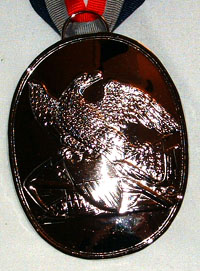 |
| Past President's Badge | Also the gift of J. Duncan Campbell the badge is a restrike of an infantry shoulder belt engraved by Moritz Furst in 1826. The first restrike was presented to Former President James Hazlett at the 1974 Fellows Meeting in Charleston, S.C. |
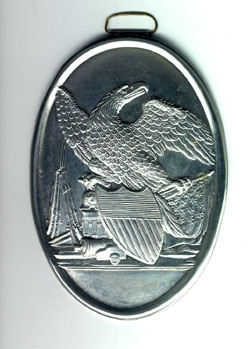 |
| Gavel | Used by the President only on formal occasions, is made from wood recovered from a U.S. gunboat sunk in Lake Champlain in 1814. |  |
| Sounding Board | Made and presented by J. Duncan Campbell in 1973, the sounding board is made from the wooden propeller of a U.S. World War I aircraft dynamo. | 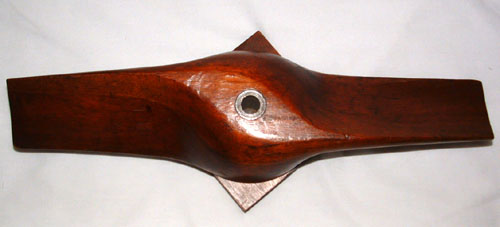 |
| Founders' Cup | The past presidents of the Company presented this silver-plated wine goblet to the company at the 2000 Annual Meeting in Washington, D.C. It honors the Company’s founders. It was created by a Korean artisan from a brass 105-mm shell casing fired during the Korean conflict. The company logo is engraved on the front with the founders names inscribed alphabetically on either side. |  |
.